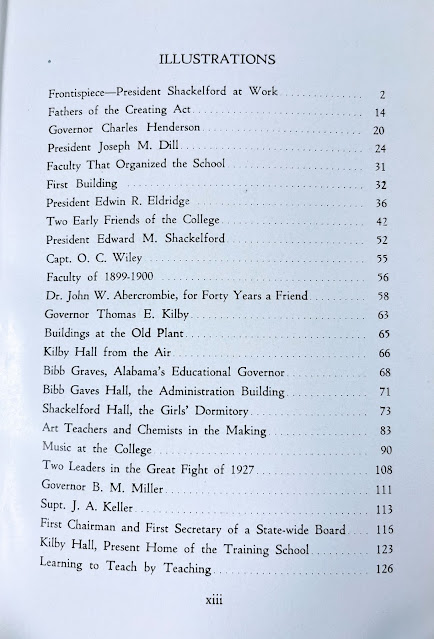The downsizing of my book collection has accelerated in recent months, and here's another departing tome that's coughed up something interesting.
The book this time is Edward M. Shackelford's The First Fifty Years of the State Teachers College at Troy, Alabama, 1887 to 1937. The volume is a detailed history of that institution up to the year of publication. What caught my attention is the extensive material in the book on the college library. Have worked in Alabama libraries for many years, I'm naturally interested in their history and have posted a number of pieces related to the topic. Some of them--but not all--can be found at Alabama Library History: A List. I really need to update that list...but I digress. I've also attempted a very incomplete chronology of state libraries up to about 1920.
Shackelford wrote this history from experience. He taught at the college for 12 years [1887-1899] and served as President for 37 [1899-1937]. At the time of publication he had been named President Emeritus in 1937. Shackelford Hall, named in his honor, was built in 1930; it's now a coed dorm.
As you can tell from the table of contents below, this book covers a lot of topics in the history of what is now Troy University prior to 1937. Two chapters cover the library. In the first one the author gives an overview based on a report written by Charlotte Smith, librarian at the time of publication. Then her report appears in full in the Appendix.
When Shackelford became President in 1899, the library had some 5000 volumes. By the time this history was written, there were some 16,000 books, 1000 government reports and about 150 magazine subscriptions. The library had been located in several different places, and the current one is shown in the first two photos below. One large room on the second floor of Graves Hall provided a reading and collection area, supplemented by workrooms.
The longer chapter by Charlotte Smith adds many details, including the names of librarians and the various sources of books in the early days. In 1909 an agreement among the Carnegie Foundation, the city of Troy and the college led to the construction of a Carnegie Library to be used by both townspeople and college students. Two librarians spent the summer of that year cataloging the 5000 books before the facility opened. Unfortunately, this relationship between the city and college only lasted a decade, as Smith details.
Shackelford's book is a a rich history of Troy in its first half century. In addition to the narrative, he has included such important lists as faculty by department, school physicians and nurses, librarians, etc. The book includes numerous photographs.















